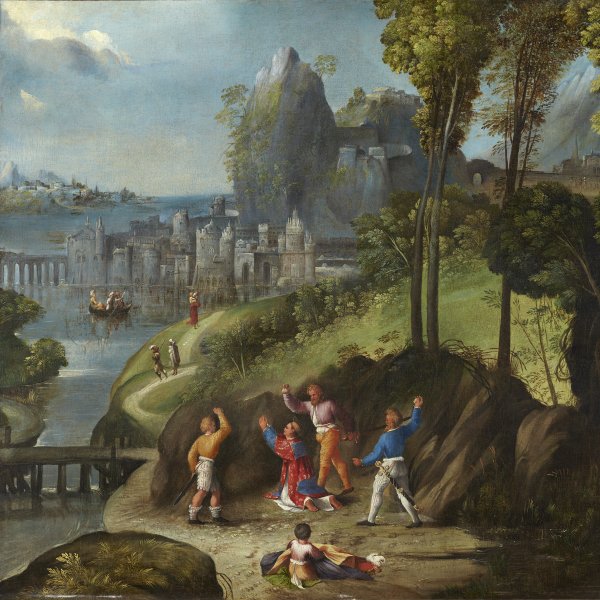Dosso and Battista Dossi
Ferrara (?), 1490-Ferrara, 1541/42, and Ferrara (?), 1490/95-Ferrara, 1548
The real name of Dosso Dossi was Giovanni Francesco di Luteri, an artist who spent most of his career in the service of the Dukes of Ferrara, Alfonso I d’Este and his son Ercole II. In his Lives, Vasari noted that the artist trained with Lorenzo Costa, but this must have been for a short period of time as no stylistic influence is evident in his work. At the outset of his career Dossi worked in Venice for Giorgione and his early works include The Loves of Circe (National Gallery of Art, Washington). In 1513 the artist moved to Ferrara, where he was involved in the execution of a polyptych for the church of San Andrea, commissioned by Antonio Costabili. It was probably in that same year that he went to Rome where he met Raphael. Dossi had contacts with central and northern Italian artists and visited Florence and Mantua.
Between 1513 and 1530, the years of his artistic maturity, Dossi’s style represents a synthesis between Titian and Giorgione, of whom the former was the most important for his artistic development. During this period Dossi’s works feature elaborate landscapes with small figures in works that reflect his fascination for the German printmakers, particularly Altdorfer. They also reveal his knowledge of Flemish art, specifically the landscapes of Patinir, who was highly regarded by the rulers of Ferrara. Among the works of this period is Melissa (Galleria Borghese, Rome), in which the influence of Raphael is evident. Saint Sebastian of 1522, in Modena cathedral, is a fine nude that manifests the artist’s study of classical antiquity and his knowledge of the work of Michelangelo and Giulio Romano. This period sees the start of a lengthy collaboration between Dosso and his brother Battista, including the frescoes for the palace of the Cardinal-Bishop Bernardo Cles in Trento. Among the artist’s last works is a group that he executed alone, including Saint Michael defeating the Devil (Gemäldegalerie Alte Meister, Dresden). In these late works Dossi departed from the style of Titian and introduced a pronounced chiaroscuro.
Between 1513 and 1530, the years of his artistic maturity, Dossi’s style represents a synthesis between Titian and Giorgione, of whom the former was the most important for his artistic development. During this period Dossi’s works feature elaborate landscapes with small figures in works that reflect his fascination for the German printmakers, particularly Altdorfer. They also reveal his knowledge of Flemish art, specifically the landscapes of Patinir, who was highly regarded by the rulers of Ferrara. Among the works of this period is Melissa (Galleria Borghese, Rome), in which the influence of Raphael is evident. Saint Sebastian of 1522, in Modena cathedral, is a fine nude that manifests the artist’s study of classical antiquity and his knowledge of the work of Michelangelo and Giulio Romano. This period sees the start of a lengthy collaboration between Dosso and his brother Battista, including the frescoes for the palace of the Cardinal-Bishop Bernardo Cles in Trento. Among the artist’s last works is a group that he executed alone, including Saint Michael defeating the Devil (Gemäldegalerie Alte Meister, Dresden). In these late works Dossi departed from the style of Titian and introduced a pronounced chiaroscuro.





